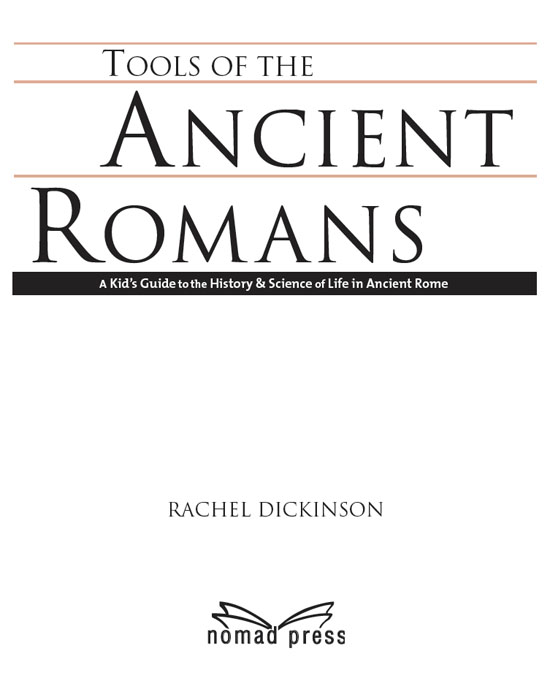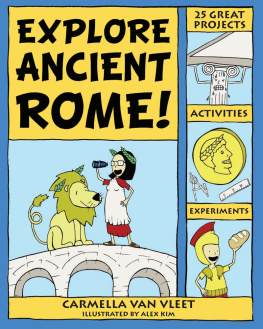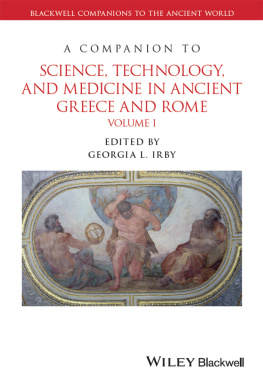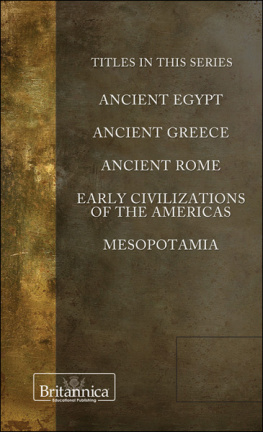
Cover image: Boris Kolomytsev, Toy Soldiers of Kolobob.
All illustrations by Shawn Braley
Photos: Scipio, courtesy of www.tu-berlin.de; Hannibal, courtesy of www.barca.fsnet.co.uk; Cato and Tiberius, courtesy of wikipedia.org; map of ancient Rome, courtesy of www.theaterofpompey. com; Shakespeare, courtesy of www.shakespeare.org.nz; other images courtesy of Planet Art
Nomad Press
A division of Nomad Communications
10 9 8 7 6 5 4 3 2 1
Copyright 2006 by Nomad Press
All rights reserved.
No part of this book may be reproduced in any form without permission in writing from the publisher, except by a reviewer who may quote brief passages in a review. The trademark Nomad Press and the Nomad Press logo are trademarks of Nomad Communications, Inc. Printed in the United States.
ISBN: 0-9749344-5-3
Questions regarding the ordering of this book should be addressed to Independent Publishers Group
814 N. Franklin St.
Chicago, IL 60610
www.ipgbook.com
Nomad Press
2456 Christian St.
White River Junction, VT 05001
www.nomadpress.net
Contents

| Timeline |
| 753 BCE: | The city of Rome is founded by Romulus on the banks of the Tiber River. |
| 507 BCE: | The Roman Republic begins after the Romans overthrow the Etruscan kings. |
| 450 BCE: | The first Roman code of law, called the Twelve Tables, is published. |
| 387 BCE: | The Gauls, from what is now France, attack and plunder Rome. This may have driven the Romans to expand north to protect themselves from future invasions. |
| 201 BCE: | Rome defeats Carthage in the Second Punic War, giving Rome control over the western Mediterranean. |
| 44 BCE: | Julius Caesar declares himself dictator for life. A large group of his fellow Senators arent happy with that and have him assassinated, plunging Rome into chaos. |
| 31 BCE: | Octavian, Caesars adopted son, defeats Mark Antony and Cleopatra at Actium, clearing the way for him to take the throne. Octavian takes the name Augustus. The Roman Empire, when Rome is ruled by emperors, begins. |
| 30 BCE180 CE: | This period of time is often called Pax Romana or Roman Peace, because the empire enjoys relative peace and prosperity. |
| 98117 CE: | Emperor Trajan rules the empire, which reaches its greatest size and power. |
| 180284 CE: | With the death of Emperor Marcus Aurelius, the Roman Empire begins a steady slide into economic and political crisis. This period is sometimes called the century of crisis. |
| 284 CE: | Diocletian becomes emperor and restructures the empire. |
| 307337 CE: | Emperor Constantine I moves the capital of the Roman Empire from Rome to the city of Constantinople and makes Christianity the state religion. |
| 370 CE: | The Goths and other barbarians push into the northern Roman provinces when the Huns from Central Asia sweep into Eastern Europe, beginning a long period of invasions. |
| 410 CE: | The Visgoths, led by Alaric, sack the city of Rome. |
476 CE:
| Odoacer, a German-born general, deposes the last Roman emperor, Romulus Augustulus, and becomes the first barbarian king. This is viewed as the end of the Roman Empire. The eastern half of the Roman Empire survived for another thousand years as the Byzantine Empire. |
INTRODUCTION
Romans All Around Us
W HY STUDY THE ROMAN EMPIRE? BECAUSE ITS influence lies all around you. From architecture and language to law and government, the Romans have influenced virtually every aspect of modern life.

Whenever you admire a beautiful classical public buildingone with columns holding up a big triangular-shaped pedimentyoure admiring Roman-inspired architecture. Wonderful feats of engineering like the development of the arch and the dome come directly from Rome. If you have been to Europe you may have actually driven on roads or traveled over bridges built two thousand years ago by Romansbridges and roads that have withstood two thousand years of wind, rain, snow, war, and traffic.
Latin, the original language of ancient Rome, is now used for the official names of plants and animals and diseasesand its also used in several legal terms. The real name for chicken pox, for example, is the Latin word varicella. As far as modern legal terms go, alibi (ala-bye), subpoena (su-peena), and affidavit (aff-ee-day-vit) are just a few Still having a hard time believing that the language of ancient Rome is being used today? Look at the back of a nickel: the phrase: E pluribus Unum is Latin for Out of many, one.
The founders of the United States turned to ancient Rome, particularly the writings of Cicero, when developing the new nation. In many ways, our government is structured much like the Roman Republic.

In Tools of the Ancient Romans: A Kids Guide to the History and Science of Life in Ancient Rome youll learn the importance and relevance of ancient Rome to our everyday lives. Youll also learn what life was like for all types of Romans in a world of gladiators and gods and goddesses, extreme poverty and great wealth, and momentous discovery. This book will give you a taste and feel of this world through activities that transport you back in time. So get your imagination ready and see what it was like to be a Roman kid, adult, senator, or slave. When you come back to the present day and look around you, youll see that ancient Rome has been with you all along.

CHAPTER
Fantastic Beginnings
Learn the story of the founding of Rome
Explore the history of the earliest Roman tribes
Uncover your own family history
T HE ROMAN EMPIRE SEEMS VERY DISTANT AND FOREIGN TO us today, but at its greatest strength, almost 2,000 years ago, it was the mightiest empire in the world. Nearly 60 million people lived under Roman rule in lands stretching from Asia Minor and Africa to Britain, about the same size as the United States. How did such a huge empire begin? It all starts with the humble and mysterious origin of Rome, the mighty city that sits on the banks of the Tiber River. The history of Rome is a fascinating mix of fact and fiction, combining archeological and scientific discoveries with ancient stories about gods and goddesses, mortals and murders, cruel kings and lost civilizations.

Next page






















